A Mobile system

This is one of several pages relating to the history of the automatic totalizator, a system that facilitates galloping trotting and greyhound race betting, its invention in 1913, the inventor George Julius and the Australian company he founded in 1917 which became a monopoly later becoming part of an oligopoly in this field. This page provides information on the mobile totalizator developed by the company Automatic Totalisators Limited. If you wish to start from the beginning then go to the index
| The Julius Premier Totemobile |
|---|
This is an extract from a sales booklet circa 1949 titled The Julius Premier TOTEMOBILE A Product of AUTOMATIC TOTALISATORS LIMITED
This is the story of the "Totemobile" - a mobile totalizator designed and manufactured by Automatic Totalisators Limited, whose Julius "Premier" fixed and portable equipment has established a world-wide reputation for efficiency and service to racing clubs and the betting public.
A Mobile system

We offer for use by clubs - whether galloping, trotting or coursing - a completely mobile unit providing the ultimate in totalizator service. It embodies more than 30 years of research based on wide experience in the totalizator field, both technical and operational, all over the world. It is precision engineered in the most modern and up-to-date plant in Australia - a plant devoted solely to totalizator manufacture.
The "Totemobile" is designed for movement to, and setting up on, provincial and country racetracks, where either the frequency of meetings or the volume of business does not warrant expenditure upon a fixed machine.
A proof of the efficiency and reputation of the equipment incorporated in this mobile unit is that the majority of fully automatic totalisators in use throughout the world to-day are Julius "Premier" totalizators.
It is appreciated that it is not possible for many provincial or country clubs to purchase an automatic totalisator, and we believe that, in offering this most modern mobile unit, we will provide a long-awaited opportunity for clubs to obtain continuous and satisfactory revenue, particularly with a view to increasing prize money and improving course facilities for their supporters.
The needs of the provincial club prompted research on and the subsequent development of the "Totemobile" by this Company, nevertheless the interest which has been shown in it by the smaller urban clubs has demonstrated its great potentiality to all clubs, irrespective of their location, which do not feel disposed to invest in a fixed installation.
The advantage to clubs and district associations from the use of the "Premier Totemobile" lies in the facility by which it enables the transfer from course to course within a circuit. The resultant regular movement will induce a following body of owners and trainers with their horses, who otherwise may not be inclined to consistent support unless the meetings are so arranged in conjunction with the regular operation of a mobile unit.
The unit is housed in a semi-trailer of streamlined design with full space for machine, staff and working area, and is powered by a diesel-engined prime mover. By means of a special chassis of our own design, the selling windows are brought down to a normal level, thus avoiding the inconvenience associated with other equipment which although mobile makes no real provision for convenient betting.
Electric power for the "Totemobile" is provided from dual engine-driven generating equipment housed in a subsidiary vehicle, which forms an integral part of the mobile equipment. This vehicle also provides storage facilities and quarters for the engineers permanently in attendance.
Of particular interest is the fact that with prime mover removed and detachable skirts fitted, the mobile unit takes on the appearance of a fixed building, thus engendering that extra confidence and satisfaction on the part of the betting public which can never be present to the same extent with obviously transportable equipment.
The "Totemobile" is designed for ticket selling on either side of the main unit with instantaneous odds indication to give up-to-the-second betting information. As required, dividends may be paid on one or the other side of the unit, according to the volume of betting taking place.
At the rear of the main unit an enquiry window is provided at which the manager may be interviewed. The great flexibility arising out of the use of any pre-determined number of ticket issuing machines, even sixty such machines being a possibility, will be most apparent - facilities for Cup Day can be expanded at will.
We state with considerable certainty that the "Totemobile" not only fulfils every possible demand that may be made by the betting public and the clubs, and is backed by the only company in the world specialising in the complete manufacture and full operation of totalizator equipment, but also is available on a basis which will be more than attractive to clubs throughout the length and breadth of the country.
To those clubs using "box ticket machines," the "Totemobile" immediately avoids the heavy expenditure upon wasted pre-printed tickets, and also removes the constant concern of all clubs that these tickets may be misused or may assist any fraudulent action. It offers every facility and service which will be found in the large installations being adopted by leading metropolitan clubs and in fact brings a city machine right to your course.
Totemobile in operation
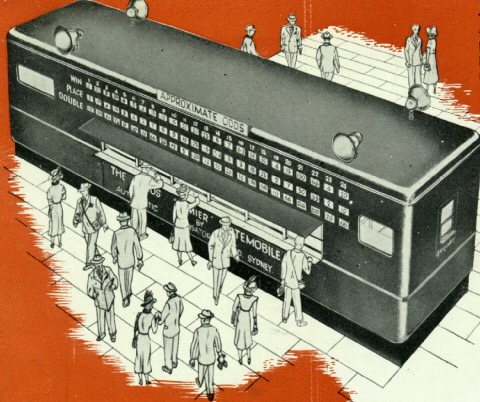
Apart from this artists impression showing the mobile tote in operation, I was struck by how differently I viewd this image seeing it ten years after I first looked at it. It now looks decidedly dated which adds to the attraction of presenting it on a totalisator history site. After becoming accustomed to all the computer generated sales material it struck me as an oddity seeing something that was more artwork oriented. Back to the sales booklet
The Totemobile in operation for win, place and double betting. At each race meeting, a cover plate bearing the name of the appropriate raceclub is affixed above the selling windows.
The centre pages of this document contains the next seven paragraphs
The machine consists of three basic components:
J8 Ticket issuing machine
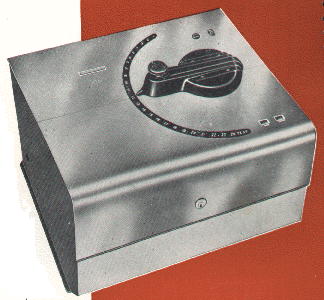
These are the very latest produced by the company, the fully streamlined "J8" model -- a predetermined number of which will issue tickets of denominations to be agreed upon by each Club within a circuit -- machines are available to sell tickets at one or two values as required. The chance of incorrect issues is greatly magnified when operators have too many possible combinations from which to select. For this reason we do not recommend the use of issuing machines selling tickets of more than two values, although this Company has available a three pool four value issuing machine designed to meet circumstances where such additional facilities are unavoidable.
Ticket issuing equipment, as well as offering Win and Place betting, includes, if necessary, provision for Double betting of the re-investment type, in which an investor purchases a ticket on his selection for the first leg and, if successful, exchanges it for his choice on the second.
On the matter of machine speed, all mechanical functions take place at a speed above the normal requirements of the betting public -- if required tickets can be issued at the rate of approximately 100 per minute.
No difficulties whatsoever arise from the scratching of accepted horses. It is mechanically impossible to issue tickets on such non-starters. As a further assistance in making the operation of the totalisator fraud-proof, a special code cylinder is utilised. This is changed automatically each race, without need of access to the issuing machines, and, of course, the advantages of printing tickets at the time each bet is made instead of having them pre-printed are enormous.
Mobile tote aggregating equipment
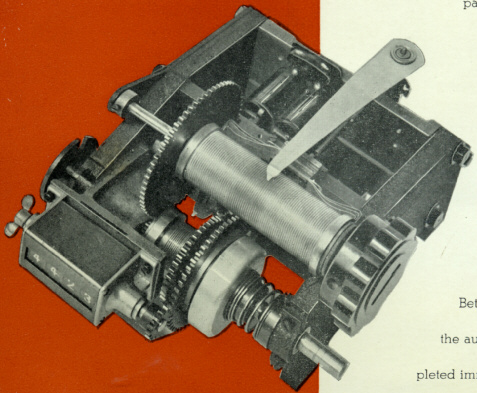
Webmaster's comment:
This mechanism is accurate and compact and has a capacity to handle betting at a rate considerably in excess of maximum selling demands. Up to 24 starters can be catered for if required. The accuracy of the adding units and all other parts of the equipment is vital for the protection of the betting public, the club and this Company. Past and present "accuracy" records of Julius "Premier" equipment have never been approached, let alone equalled, by any other equipment.The aggregator in the image above is a piece of equipment I have never seen anywhere else. I have asked everyone who might have known what type of adder this is and no one did. It must perform the same function as the aggregator/adders referred to in other sections of this website. I know nothing of how it works! This makes it intriguing and I just had to include this image... Many years after the preceding sentences were written, I made one final attempt to find anyone who knew anything about it. Neville Mitchell, an ex Automatic Totalisators Limited Engineer and Manager, who is the best company historian I know, rang me to say that he too is mystified by this adder. He indicated that he thought this adder looked the same as the two grand total adders seen on top of the four rows of six runner adders in the frame of adders shown in the image below titled Mini Adder/Aggregator System. Neville subsequently emailed me with information that he had determined from examining the image above. Instead of detracting further from the Julius Premier TOTEMOBILE booklet, I will include Neville's information at the end of the booklet section where it is labelled Webmaster's comment continued.
As a check against the individual adding of bets on each starter which takes place on the adding units for all pools, there are also grand total adding units which record the total of all bets in each pool.
Betting will take place right up to barrier rise. Even then, because of the automatic nature of the equipment, dividend calculation will be completed immediately the winning jockeys have weighed in. This advantage will be fully appreciated by your club when it is realised that dividends will be returned to the public virtually within seconds of the correct weight signal.
I have not included the image of the odds indicator as it can clearly be seen above the selling windows on the side of the trailers in the images.
The company has perfected a number odds indicator of the shutter type, which instantaneously displays the odds during the course of betting. The bank of indicators will be clearly visible up to distances of some hundreds of feet and will provide your patrons with an excellent up-to-the-minute picture of the state of betting on the course.
It has been our experience over many years that, with the exception of unusually short-priced starters, the totalisator will show more favourable odds over those called by bookmakers, if standing. As all racing clubs are aware, the financial return to the club from the totalisator is vastly superior to that received from bookmakers, and the immediate indication of such favourable odds will attract more business to the totalisator.
The last page of this document reads
As the operation of the totlisator will be the Company's responsibility, the preparation of the records to be supplied to the controlling authorities by the club would be our task, although the payment of unclaimed dividends when necessary will have to be attended to by each club concerned.
In providing maximum service and to preserve the machine's reputation, the Company would be responsible for the entire mechanical and clerical operation of it, including the movement from course to course, so that the club's only responsibilities would be to arrange its meeting dates in the best interest of the circuit, and to have a suitable clear area upon the course on which the "Totemobile" would be located.
The terms under which the company may best operate the unit would of course be the subject of periodical agreement with the clubs or association. This scheme presents a unique opportunity as, without capital outlay or any pre-meeting responsibilities, all race clubs will be able to receive a remuneration based upon a predetermined percentage of the turnover.
It is with justifiable pride and confidence we suggest we be allowed to demonstrate this mobile unit to you, as it is our firm conviction that if provincial and country racing is to encourage and secure the consistent public support it deserves, the operation of this most modern totalisator -- the Julius "Premier Totamobile" -- on all courses is by far the surest means of achievement.
Enquiries from your club will receive our urgent and closest attention if addressed to:
AUTOMATIC TOTALISATORS LIMITED
MEADOWBANK NEW SOUTH WALES
AUSTRALIA
So ends the The Julius Premier TOTEMOBILE document. The address above is of the Meadowbank factory as seen in the image below. The Mobile Tote in this image is installed inside an Ansair Bus.
A Totemobile at the Meadowbank Factory
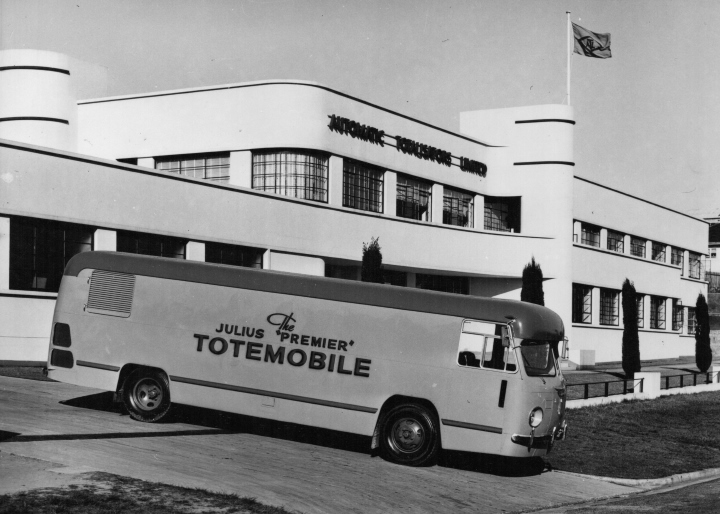
Ian Waugh, an ex Automatic Totalisators Limited engineer in New Zealand provided the image above. Following is an extract from an email he wrote relating to this image: The photo is one of several which came from our Auckland office when NZTAB took over NZ operations. You will be aware that there were quite a few Totemobiles put into service, both the Ansair bus type and articulated.
When Ian broadcast the image above to the ex ATL fraternity, Nick D'Angelo, an ex Automatic Totalisators Limited long serving system manager suggested I should display it on this website, so here it is. Nick also wrote the following about it: That's a great pic of the early Totemobile complete with ATL flag flying extended in the breeze. The flag is near the top right corner of the image and has the ATL diamond logo on it.
 Go back to the index
Go back to the index  Go to the bottom of the page
Go to the bottom of the pageFollowing is the information Neville emailed me regarding information he had determined by examining the image above titled Mobile tote aggregating equipment:The more I study this device the more intriguing it becomes. Firstly I'm convinced it's a Grand Total Accumulator Counter.After having read Neville's comment about this above, I now totally agree with Neville. The Wheatstone Bridge like device, which is probably used as a potentiometer as seen in the image above titled Mobile tote aggregating equipment, is not part of the adding functionality but the odds display system. In a higher resolution version of the image below titled Mini Adder/Aggregator System, there are crude circular wire wound disc shaped potentiometer like devices which can be seen at the back of the frame behind the 24 adders seen in the foreground. Each of these is associated with the odds indicator drive system and there is one for each of the 24 circular Odds Display Discs which are predominant in the foreground underneath each of the adders. Even in the image below titled Mini Adder/Aggregator System, these crude potentiometers can be made out as discs mounted on the opposite side of the beam to which the Odds Display Discs are mounted in the foreground, as best seen in the first row of four rows of adders, one behind and to the left of each of the Odds Display Discs in the foreground. These crude potentiometers at the back of this frame are doing the job of the wire wound device looking like a Wheatstone Bridge on top of the adder in the image above, which is why the adders shown in the frame below, which look the same as the one in the image above, do not require the Wheatstone Bridge Device on top.The single trip solenoid assembly would align with a standard Julius electro mechanical totalisator. However I can not confirm or see from the photo where the essential escapement rocker mechanism operates on the second gear wheel then to the first friction driven gear wheel. The second gear wheel is linked to the large gear wheel that drives the "Rotary Potentiometer" which is thought to be a leg of a Wheatstone Bridge circuit used to drive odds indicating devices for instance.
The resistance wire is spirally wound and the stylus follows the spiral as the accumulator accepts the inputs. It appears that the stylus arm is manually reset and then accurately adjusted by the large Bakelite knob. The resistance wire is terminated at each end of the roller onto brass slip rings, the fine wires are possibly the conductors for the potentiometer circuit.
The Veeder Root rotary Counter was commonly used on all adders of this era, reset by the butterfly knob (The resetting of these counters was one of those "Check on the Check" items as a incorrect reset to all zeros would stall the counter.)
The input shaft (RHS) appears to be designed to mesh with the adder frame line drive input shaft. The slotted disc on the LHS is some sort of coupling to what? Maybe it is used when this device was used as a horse Adder?
This mysterious device has been around for some time. I had shown the photo to Bill Johnstone, Peter Collier and Bill York all of whom said they had never seen it before.
Julius Tote Odds Calculators
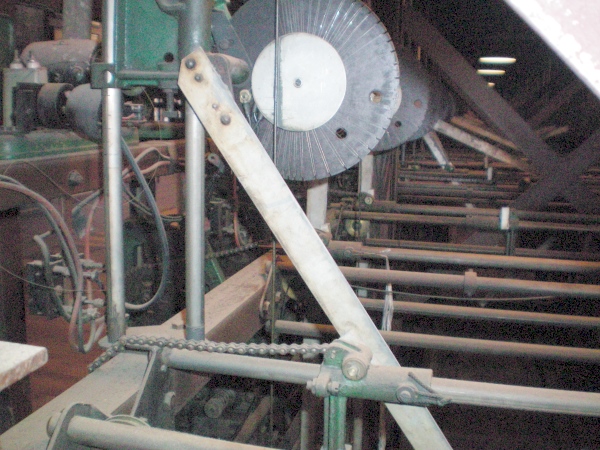
I have included the image above as it shows what I have called a crude potentiometers. There is one at the top centre of the image above which relates to a single runner and the row of these potentiometers can be seen disappearing into the distance, which relate to all the other runners in a race. The image above is of the Eagle Farm Julius Tote, which is a full sized Julius totalisator not a mini sized mobile system. These potentiometers in the image above are the same as the ones behind each of the odds discs in the image below. Whether the ones in the image below are miniaturised ones is hard to tell.
After Neville read my comments about the crude potentiometers, he sent another email in which he informs me the ones shown above are called hand wound Resistor Fan assemblies. An extract from Neville's email follows:
Re Eagle Farm "Crude Potentiometers" are a Wheatstone Bridge leg. I had often seen the production version on other adder systems. They were a more modern version made up of IRH# 20 ohm 1/2 watt resistors. They were still in production circa 1962/3. They were called Resistor Fan assemblies about the same size as the Eagle farm hand wound resistor fans. I still have a few of these resistors in my spare parts box labelled 1 to 100 ohms. The wiper on the Fan type Assemblies was similar to that shown in the adder photo wiping around the brass studs that have the series of 20 ohm resistors soldered to them.End of Webmaster's comment.
#IRH International Resistance Holdings P/L was a Sydney company in Homebush that produced most types of resistors from wire wound to the modern metal film developments.
Mini Adder/Aggregator System
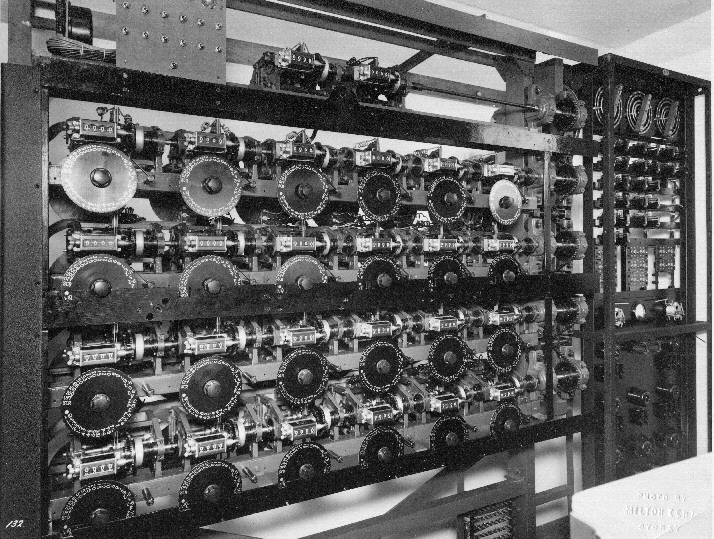
The image above shows a mini adder/aggregating system of the type used in mobile applications. The circular devices at the top of the right hand rack are scanners which are electromechanical time division multiplexers. The equipment in the frame to the left of the right hand rack are the adders or what were earlier known as aggregators. The circular disks associated with each adder show the odds which are also shown to the public outside the van. The two adders on top of the frame of adders, to the right of the panel with banks of switches, are the Win and Place Pool Grand Total Adders.
Mobile tote cutaway
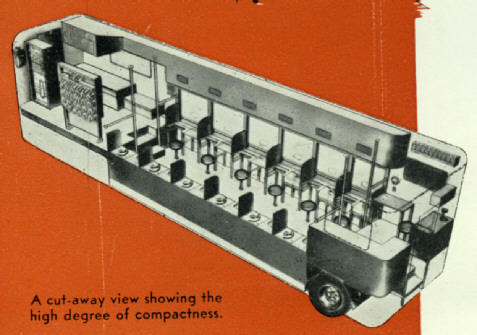
The Mini Adder/Aggregator System shown two images above can be seen installed down the left hand end of the van in this Mobile tote cutaway image above. The back of this system is visible in the cutaway image but the two racks of equipment can clearly be seen in the mobile.
Following are some memories from Rod Richards, an Automatic Totalisators Limited engineer, who worked on the Julius Totalisators and remembers assisting with driving one of these Totemobiles from the Meadowbank factory to Adelaide, as well as getting it started on the rounds. The image above titled A Totemobile at the Meadowbank Factory shows one of these Totemobiles standing outside the Meadowbank factory and it could be the one Rod drove to Adelaide. Although several of this type of Totemobile were made, judging by the pencil pines growing along the front of the factory this could have been 1950. And now Rod's recollections:
I first got my driving licence in Adelaide, in order to drive the Totemobile legally; I did drive the Totemobile part of the way from the Factory to Adelaide under instruction. To get your licence then, all you had to do was answer 14 questions out of the Drivers Hand Book and you got your full licence, no driving test was required. In those days, in Adelaide (1950) you had to have a licence to learn to drive and with that licence you could legally drive any motor vehicle except an Omnibus and other special vehicles - cars, trucks, motor bikes etc were all OK on the same licence - times have changed.
Webmaster's comment:
It's a long drive from Sydney to Adelaide! It is interesting to note that Rod having to sit his first driving test at 85, triggered the above recollection. This driving test is mandatory for anyone wishing to continue to drive in Australia, on reaching the age of 85.
The Totemobile Rod drove to Adelaide
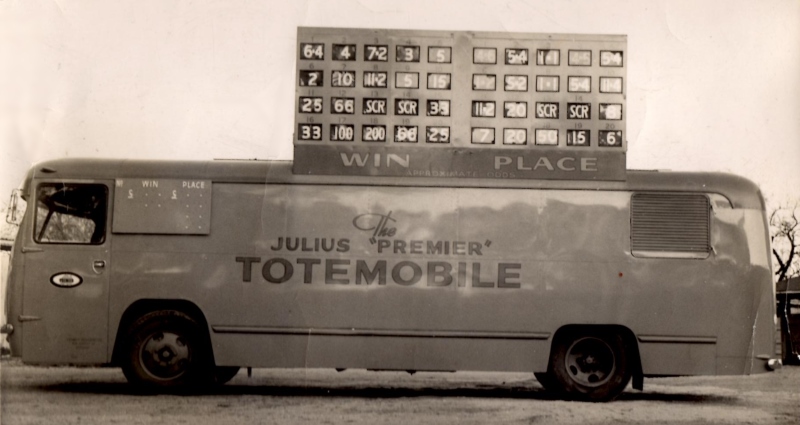
Rummaging through a lot of family photo's I came across the photo of the Totemobile we built up at Meadowbank and drove to Adelaide. The photo was taken by the Adelaide Advertiser Newspaper on 30th July 1952, after we arrived from Sydney. The Advertiser was interested as it was at the time, quite unique to have such a vehicle to operate the mid-week country races.
The Totemobile was fitted out using an Ansair Bus, part of the Reg Anset Transport group, I think. The bus was fitted out with adders and the operating system as a fixture, the power supply was by two Ford 10 engines driving 120 volt DC generators; one being a backup; the power supply was enclosed at the back of the bus.
We carried a number of J8 TIM (10?) to locate in the pre-existing selling houses at each racecourse. The indicators, 10 banks of 4, which were also carried in the bus, were raised through the opening in the roof of the bus, after the display board was raised from the roof of the bus and fixed in place. After the indicators were set up and working, the whole arrangement was covered by a canvas cover over a frame work.
There was usually a crew of 3 on race day, which was rather a long day; to drive to the race track, the distance varied as there was a number of tracks spread around SA. Set up and run tests then after the last race, pack up the bus and drive home again.
From memory we operated at - Tailem Bend, Murray Bridge, Gawler, Claire, Kapunda, Balaklava, Port Pirie and Port Augusta. At Port Augusta it was an annual meeting of two or three days duration.
One incident at Balaklava caused quite an upset, as during the early part of the meeting, things started going wrong with the betting on the Tote, as it turned out the Win and Place cables, which had the same type of plugs, were connected to the selling house reversed; the Win cable was connected to the Place side and the Place cable connected to the Win side. It was not immediately apparent what the problem was, so the Tote was shut down and a manual system operated for the rest of the meeting. As a result when the problem was discovered, the plugs were altered for the next meeting, so that the this could not occur again.
Webmaster's comment:
Ironically, I have seen this problem a few times in the computer era in which I worked for Automatic Totalisators Limited, where the Win Pool figures were displayed on the Place Pool Indicator and vice versa, due to the plugs being accidentally crossed over. These were at different locations and each time it happened sufficient markings were placed on the plugs and sockets to ensure it never happened again at that location. Fortunately, the first time I came across it, we had an astute branch manager Roger Penwarden, who quickly noticed the Place Pool GT was larger than the Win Pool GT and immediately said that's wrong, to the technician who had just installed it and started it up. In this event, the indicators were transported between tracks requiring the Win and Place display panels to be disconnected from their controllers for transportation and plugged in again at the destination.
| A look at two different Totemobiles |
|---|
Warrnambool Totemobile
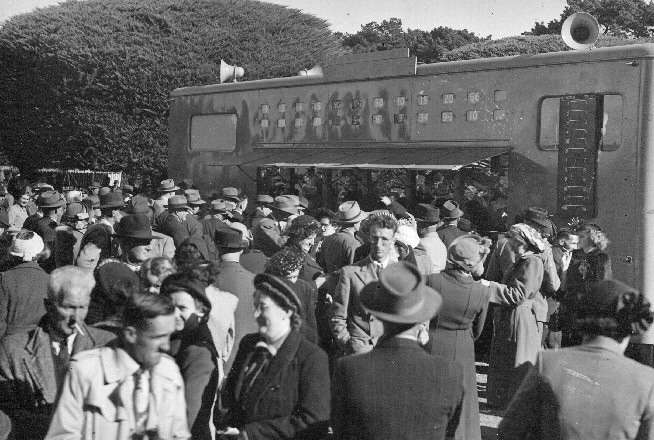
This is an image of a real mobile tote in action in Warrnambool in Victoria. The crowd density is reminiscent of scenes at metropolitan race meetings of this era. It seems to give credence to the assertion of the sales brochure, included under the heading "Focal Point On Course" above, about the totemobile becoming the focal point of the racetrack. I have enlarged and examined the sign section at the top centre of this totemobile in the high resolution copy of it and discovered the words "WARRNAMBOOL RACING CLUB" on the upper board and "APROXIMATE ODDS" on the lower wider board.
Following is an article from the Kalgoorlie Miner titled Automatic Tote written in 1949 and extracted from the Trove Australian Newspapers Online archive. It describes the type of Totemobile as shown in the above image as indeed with all images and descriptions presented above.
1949 'AUTOMATIC TOTE.', Kalgoorlie Miner (WA : 1895 - 1950), 11 February, p. 8, viewed 7 May, 2015, http://nla.gov.au/nla.news-article95714596
AUTOMATIC TOTE
Mobile Units Being Built
SOLVE DIFFICULTIES OF COUNTRY CLUBS
A mobile automatic totalisator that can be driven from one country centre to another at up to 40 miles an hour is being built by Automatic Totalisators Ltd. (Sydney). It will be the first of a fleet of 20, each of which will handle £15,000 a day.
Mr. Spencer Grace, managing director of Automatic Totalisators, said this was his company's answer to the difficulties of country racing clubs considering installing automatic totalisators.
The mobile machine could operate at a race meeting in the day and move on to a dog track or pedestrian meeting at night, he said.
All the clubs would have to provide would be a concrete apron 40 ft. by 16. ft., on which to operate the machine.
The machine has a built-in odds indicator on all runners for a win and a place. At one end will be the self-powered calculating unit, and at the other the bank and inquiry office.
Automatic Totalisators Ltd. will provide staff and all facilities. The machine will be worked on a percentage basis without cost to the club.
The "prime unit," as the traction power is called, is a Diesel motor and is detached during a meeting. Skirts are let down on the sides of the tote, giving it a compact appearance. It can provide £1, 10/ and 5/ windows or bets of any other denomination.
One side of the tote has pay-out windows or, alternatively at a big meeting, both sides can be used as selling windows and a club building could be used for the payment of winning bets
Length of the vehicle over-all is 45 ft. Operating unit is 35 ft. by 8 ft, and 11½ ft. high.
Full racecourse operating totes are being erected by the Australian company in Brazil, Columbia, the United States, New Zealand, India, Burma, Malaya, the Philippines and South Africa.
Twenty-six totes are to be erected in Australia--five in Western Australia, two in South Australia, eight in New South Wales, six in Victoria and five in Queensland.
The image below shows a Miniadder System inside a semitrailer which was built for the Melbourne Metropolitan Racetracks. It commenced operation in 1964. There were two 40 foot pantechnicon trucks which were fitted out as 24 starter win place only tote equipment and had a lot of innovative features with automatic hard printout for results and dividends and end of day summations. This system is of a different category to the other mobile systems presented so far. Unlike the others this system did not cater for small raceclubs but for large metropolitan raceclubs. Its mobile architecture allowed for this significant investment in hardware to be shared by 5 racetracks.
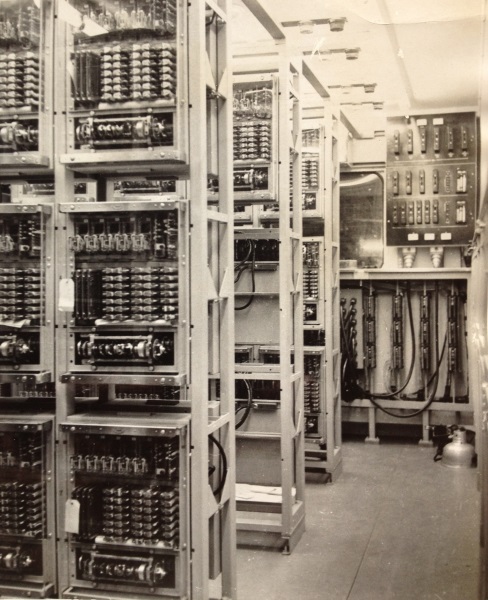 The Melbourne Metro Miniadder System.
The Melbourne Metro Miniadder System.
Peter Collier who was the Chief Engineer in Victoria at the time made the following comment about this photo: It is actually a photo taken inside the van looking towards the rear. We had 2 of these vans servicing the Melboune metro tracks until they were replaced by the 11/40 computer vans in 1973. If I remember properly these vans were gutted and were reused for the Brisbane Sell/Pay system.
If Peter recalls correctly, these vans came to Brisbane and housed the PDP11/34 systems that I worked on for near a decade. There is a chapter in this website titled ATL The Brisbane Project, which covers the PDP11/34 totes in Brisbane. This is accessible from the index page which can be accessed from the navigation bar at the bottom of this page.
Neville added this following comment about the above photo via email: A view of the Place MMRC adders taken in the mobile van installed in 1964/1965 which opened at Sandown Park on 19 June 1965. Note the many Canon connectors that were used to connect the van to the track.
| The Julius Premier Totemobile |
|---|
The following table returns to the document "The Julius Premier Totemobile" and contains a small extract of the installations listed in this document. I must point out that these are almost all fixed site installations and not mobile systems. I have included this here despite a similar table in another page as the listing is in number of ticket issuing machine order and some large installations can be seen together. This document is more modern than the one that the installations listed in the Installations/Testimonials - The Premier Totalisator chapter and consequently show the latest number of terminals as additional machines were often installed. It is divided up into 3 sections. The first is titled JULIUS "PREMIER" TOTALISATOR INSTALLATIONS completed prior to World War 2 The second is titled JULIUS "PREMIER" TOTALISATOR INSTALLATIONS completed since World War 2 The third is titled JULIUS "PREMIER" TOTALISATOR INSTALLATIONS now being manufactured I have extracted some of the entries from under the first and third title. The final entry I have provided is under the third title I find exceptional as this system has an asterisk in the Number of Issuing Machines column with a footnote * Capable of taking a total of 828 Issuing Machines. I recall seeing a transcript of a speech given by Charles Norrie the northern hemisphere expert on George Julius and totalisator history talking of a large system like this in the UK however this is the first time I have seen evidence of an installed system capable of this capacity. A demonstration system was built in Sydney in 1920 capable of supporting 1000 terminals.
A final selection criteria, for the two tables I have included, is customers not mentioned in the table in the Installations/Testimonials - The Premier Totalisator chapter. Finally, the red enlarged text for the 828 is my emphasis which does not exist in the original document.
| Where Installed | Type | Total | No. of | No. of |
|---|---|---|---|---|
| runners | Indicators | Terminals | ||
| or combs | ||||
| WHITE CITY STADIUM London England | W. P. & F. | 42 | 3 | 320 |
| LONGCHAMP France | W. P. | 84 | 4 | 273 |
| EMPIRE STADIUM WEMBLEY England | W. P. & F. | 42 | 3 | 272 |
| HARRINGAY RACECOURSE England | W. P. & F. | 42 | 1 | 220 |
| VICTORIA RACING CLUB Australia | W. P. | 60 | 5 | 140 |
| AUSTRALIAN JOCKEY CLUB Australia | W. P. | 48 | 3 | 133 |
| WESTERN INDIA TURF CLUB India | W. P. | 48 | 1 | 126 |
| MIAMI JOCKEY CLUB U.S.A. | W. P. & S | 45 | 2 | 110 |
| ... Following entries out not contiguous ... | ... | ... | ... | ... |
| BELLE VUE RACECOURSE England | W. P. & F. | 42 | 1 | 85 |
| EASTVILLE STADIUM England | W. P. & F. | 42 | 1 | 74 |
| TYNESIDE SPORTS STADIUM England | W. P. & F. | 42 | 1 | 44 |
| FIELDING JOCKEY CLUB New Zealand | W. & P. | 48 | 1 | 32 |
| MOOREFIELD RACING CLUB Australia | W. & P.(Port.) | 42 | 2 | 32 |
| WILLENHALL RACECOURSE England | W. P. & F. | 42 | 1 | 30 |
| PENANG TURF CLUB Fed. Malay States | W. & P. | 32 | 1 | 30 |
| STENHOUSE STADIUM Scotland | W. & P. | 12 | 1 | 27 |
| BRISBANE AMATEUR TURF CLUB Australia | W. & P. | 32 | 2 | 20 |
| WILLOWS AND COLWOOD PARK Canada | W. P. & S. | 30 | 1 | 20 |
| PERAK TURF CLUB Ipoh, Fed. Malay States | W. & P. | 32 | 1 | 18 |
| MORNINGTON RACING CLUB Australia | W. & P. (port) | 40 | 1 | 7 |
| PAKENHAM RACING CLUB Australia | W. & P. (port) | 40 | 1 | 7 |
| ... OTHER ENTRIES ... | ... | ... | ... | ... |
| Total | No. of | No. of | ||
|---|---|---|---|---|
| Where Installed | Type | runners | Indicators | Terminals |
| or combs | ||||
| JOCKEY CLUB BRASILIERO Rio de Janeiro | W. P.& D. | 40 | 5 | 250 |
| HARRINGAY RACECOURSE England | Forecast. | 30 | 1 | 198 |
| VICTORIA AMATEUR TURF CLUB Australia | Extensions | Portable | Equipment | 180 |
| MOONEE VALLEY RACING CLUB Australia | Extensions | Portable | Equipment | 180 |
| WILLIAMSTOWN RACING CLUB Australia | Extensions | Portable | Equipment | 180 |
| AUSTRALIAN JOCKEY CLUB Australia | W. & P.(Port.) | 48 | 5 | 164 |
| ROYAL CALCUTTA TURF CLUB India | W.& P. | 48 | 6 | 161 |
| AUKLAND RACING CLUB New Zealand | W. P. & D. | 24 | 4 | 100 |
| ... Following entries not contiguous ... | ... | ... | ... | ... |
| SYDNEY TURF CLUB Rosehill Australia | W. & P. (port) | 48 | 1 | 93 |
| SYDNEY TURF CLUB Canterbury Park Australia | W. & P. (port) | 48 | 1 | 93 |
| SYDNEY TURF CLUB Rosehill Moorefield Australia | W. & P. (port) | 48 | 1 | 93 |
| TASMANIAN RACING CLUB Australia | W. & P. | 24 | 2 | 30 |
| ... OTHER ENTRIES ... | ... | ... | ... | ... |
| GREYHOUND RACING ASSOCIATION LTD. England | W. P. & F. | 42 | blank | * |
As the above table has introduced some of the large systems and this page has been looking at the small end systems it makes a good contrast to compare these miniature systems with a piece of equipment from one of the large ones. The White City Stadium London system is mentioned above. The following image shows a single adder from this system. As the number of machines this adder has to support, 320 which is probably not the maximum it is capable of supporting, it is massively larger than the adders in the mobile system. The image shows the adder corresponding to runner number 5. As can be seen it is mounted on a table and the whole system fills a room. I suspect this adder consumes more space than the whole mini adder mobile system.
Large System Adder/Aggregator at Longchamps
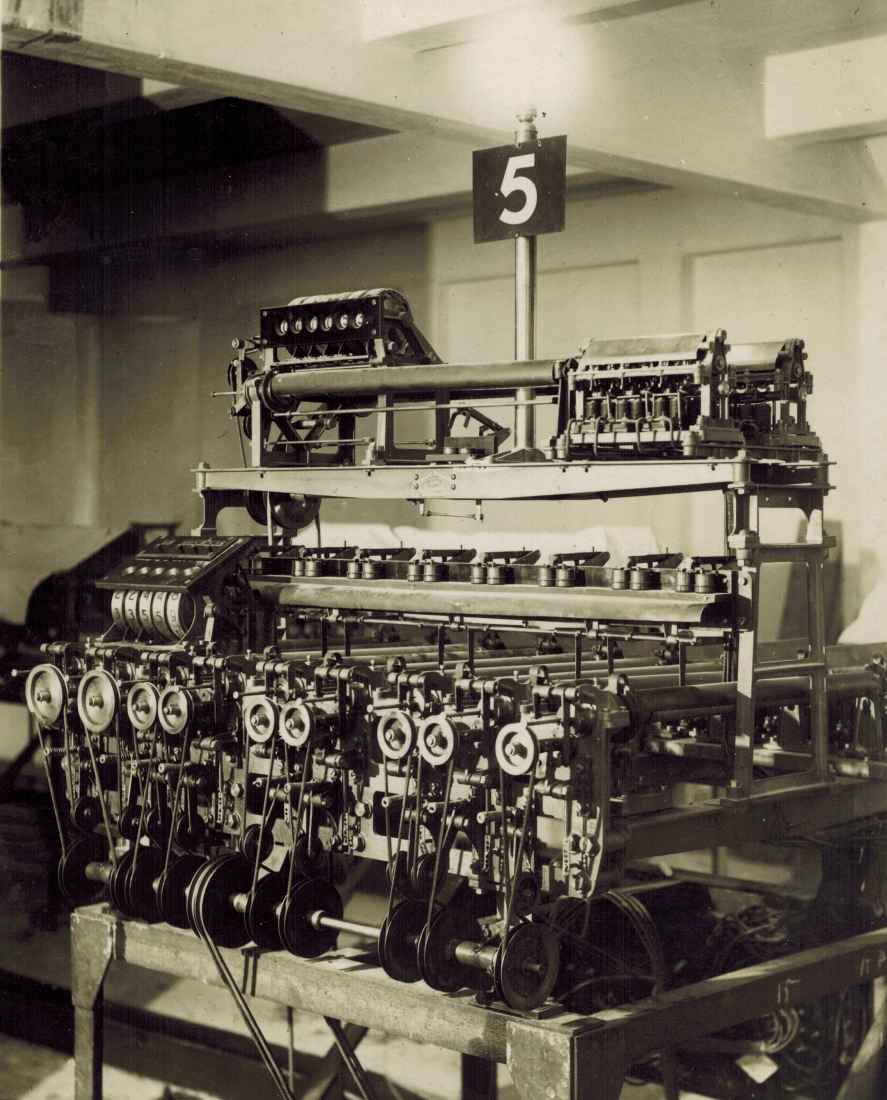
| The Microtote |
|---|
As the subject of this chapter is the mobile tote, this segment looks at the mobile after the introduction of computers. It appears on the back cover of the Winter 1978 Tote Topics magazine.
This computer operated totalisator system is the first of a new generation of totes designed primarily for the use of smaller Clubs. The system will handle twenty four starters in a race. Up to sixty-four J8, J10, J11 and J18 ticket issuing machines can be used and it is fully duplicated. There are outputs for four different closed circuit television information channels.
Due to public demand the first system has been programmed initially to operate a Trifecta pool using J11 TIMs and will service Bankstown, Bulli, Fairfield and Menangle Park trotting meetings, plus Bulli greyhound meetings, all in New South Wales, Australia.
The equipment has been installed in an eighteen foot purpose-built caravan and this is towed from track to track by a Ford F100 V8 truck. There is an emergency petrol generator and also storage batteries.
This combination was chosen instead of a self propelled vehicle in order that the Ford could also be used for other purposes and that in the event of a breakdown a replacement towing vehicle could be easily obtained. The caravan is fitted with air conditioning and apart from the computers, control consoles and printers, contains facilities for receiving the race broadcast, intercom to totehouse and commentators, four fixed T.V. monitors, a portable T.V. monitor for displaying the Trifecta progressive pool and the dividends, work space for two Control personnel and one Totalisator Agency Board Official.
All cables are led through a special waterproof cable box at the rear and when the caravan arrives at a track these are plugged into a distribution box at the main totehouse and the system is ready to operate. The second phase of operations will be a new programme to encompass win, place, quinella as well as trifecta and betting on three different meetings at once.
The main advantages of the Microtote are:
Operations started in May 1978 with complete success. The Sydney press complimented the clubs on their introduction of the Micro Tote and pointed out the speed at which the dividends including Trifecta were declared.
This article pre-dates the one above.
Automatic Totalisators Limited is releasing a totally new totalisator system which takes full advantage of the latest advances in electronics to provide a completely portable miniature totalisator system. The system offers features previously only available on much larger and more costly systems. Called the Microtote this system offers for the first time, sophisticated totalisator facilities to small and medium sized racing clubs.
Microtote provides low cost, computerised totalisator facilities such as automatic odds and dividends calculation and display for Clubs with small to medium totalisator turnovers.
There are two models of the Microtote. Microtote I which caters for a simplified version of the new J22 terminal and Microtote II which caters for all previous ATL ticket issuing machines. A typical Microtote will allow betting on the local and two remote race meetings. The available pools are a maximum of 24 starter WIN/PLACE and a maximum of 24 starter QUINELLA or FORECAST for each track. In addition one only 24 starter TRIO or 12 starter TRIFECTA pool may be assigned to any one of the three tracks at the start of the day. An alternative system might comprise a 16 starter TRIFECTA and 24 starter WIN/PLACE facility on a single track. The complete system is controlled via two Totalisator Control Consoles. These consoles incorporate data entry, track selection and command keys as well as function indicators and a video display of system status. They will provide the following functions:
| Pool Selection | Runner Selection | Start Betting |
| Clear Board | Stop Betting | Results Entry |
| Off_course Entry | Negative Tickets | Compute Dividends |
| Display Automatic Odds | Print Totals - Current | Race Increment |
The operators are able to use either Totalisator Control Console for any control function or any track. The input comes up on the Video display as it is keyed in by the operator. If the data is correct then the operator depresses a TRANSMIT key and the information is entered into the system. This facility allows the operator to correct errors before they are entered into the system.
The system consists of the following units:
| 1. Dual Central Processing Units | 2. A Pair of Logging Terminals |
| 3. Two Totalisator Control Consoles | 4. A Dual Floppy Disk Bulk Storage |
| 5. Video Odds Indicating Monitors |
The dual nature of the system provides a back up for fail-safe operation and this Microtote is designed so as not to require highly skilled operators.
| Acknowledgements |
Comments and suggestions welcome to
totehis@hotmail.com 
| Previous page | Go to the index | Top of the page | Next section |